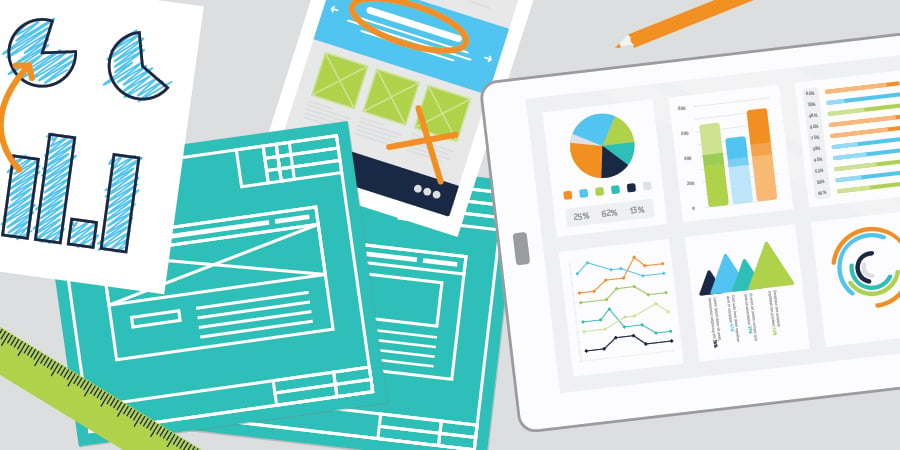Our Recap of the McKinsey Report on the Business Value of Design
 Taylor
|
Taylor
|

I once read a quote by Irene Au that said, “Good design is like a refrigerator — when it works, no one notices, but when it doesn’t, it sure stinks.” This quote highlights a fact that is ever apparent in today’s world.
Based on the frequent interaction we experience from companies like Amazon and Apple, it’s easy to make the case we all interact with great brand designs on a day-to-day basis, but often it goes unnoticed.
Hear me right. I’m not arguing that people pass by quality design without a care in the world. (To be honest, it's those brands that often are the best ones.) What we're looking at here — the disconnect, if you will — is how companies can miss opportunities to market through design. Design has value. So, when companies see the bigger picture and understand the impact that design can offer and the results it can drive, opportunities emerge.
McKinsey & Company is working to help others understand this value.
To do that, the team at McKinsey & Company posed the questions:
“How do companies deliver exceptional designs, launch after launch?”
“What is design worth?”
To get the answers they conducted “the most extensive and rigorous research undertaken anywhere to study the design actions that leaders can make to unlock business value.” And in October 2018, they published their report, The business value of design. To save you some time, we read the results and wrote up a recap.
In their report, McKinsey & Company tracked the design practices of 300 publicly listed companies over a five-year period. They gathered more than two million pieces of financial data and recorded more than 100,00 design actions. Through all this information they uncovered four broad themes.
They took these four themes and formed them into the basis of the McKinsey Design Index (MDI). By creating this type of index, McKinsey finally has a way to quantify the value of design. The index rates companies by how good they are with design and links the information with financial performances.
Photo credit: McKinsey & Company
These results are remarkable. Companies that showcase top-quartile MDI scores increase revenue and total returns to shareholders by nearly twice the rate of their industry counterparts. And the results were consistent across all three industries observed (medical technology, consumer goods, and retail banking).
The proof seems to be in the pudding. The results provided by this index prove the possibility for design-driven growth is impressive. The benefits will not only be captivating user experiences but financial growth as well. This means focusing on user-centric, iterative design is the way of the future for a vast majority of companies.
Understanding the Four Themes of the MDI
So now you may be asking yourself: This information is impressive but what do I do next? What do I do with these results and information? How do I put them to use in my company?
Well, remember earlier when I said the MDI was constructed of four main themes? It turns out they offer great insight into some best practices you can follow.
The four themes are as follows.
1. More than a Feeling: It’s Analytical Leadership
McKinsey found that companies that performed best financially understood that design is an important, top-management issue. They also assessed their design performance with the same rigor they used to track revenues and costs. This breaks a norm that happens with design – instead of treating design as a “second-class citizen” they give design leaders a seat at the table.
Don’t let this fool you, though. It’s not enough to merely give design the seat. There’s significant value in maintaining a baseline level of customer understanding.
The McKinsey report provides the following example:
"One top team we know invites customers to its regular monthly meeting solely to discuss the merits of its products and services. The CEO of one of the world’s largest banks spends a day a month with the bank’s clients and encourages all members of the C-suite to do the same. Through personal exposure or constant engagement with researchers, executives can act as role models for their businesses and learn firsthand what most frustrates and excites customers.”
2. More than a Product (or Service): It’s User Experience
Companies that performed in the top quartile of the MDI embrace the full user experience — that includes knowing how to break down barriers between physical and digital environments. They’re pushing the boundaries between products and services and merging them into integrated experiences.
For example, a charity that works with volunteers might consider looking for early engagement through social media and social sharing. By encouraging people who are already committed to a cause to share within their own network, you have ample opportunities to share your mission and connect with their friends, family, and colleagues.
Another example includes offering out-of-the-norm solutions like mobile payment services such as Google Pay or Apple Pay at the charity’s events. We see fewer and fewer people carrying cash these days. Sure, most of us have a piece of plastic in our wallet, but mobile payment services could be an even easier solution to allow people to engage and donate.
It’s more important than ever to understand the customer journey and gather insights into the underlying needs of consumers. McKinsey claims that “these insights must be championed at every meeting.” Because once you have a better understanding of the customer journey (including their pain points!), you can better see where design can make a difference.
3. More than a Department: It’s Cross-functional Talent
Here at TANK New Media, we’ve always valued integration and mutual success. When our founders, Krista and Thad Ankenman, started TANK they envisioned a less-siloed approach, making room for everyone to bring their strengths to the table. This same approach is critical to helping achieve a top quartile MDI score.
The McKinsey & Company report found that “top-quartile companies make user-centric design everyone’s responsibility, not a siloed function.” This means companies will greatly benefit from cooperative work between departments. And while not a new concept, hybrid designers, who work across functions and disciplines while retaining their design savvy, will be the ones creating the most impact and ROI through their work.
Design already has so many touchpoints in business; companies that value the integration of user-centric design and take the time to invest in it will see the investment pay off.
McKinsey found a strong correlation between successful businesses and companies that “resisted the temptation to cut spending on research, prototyping, or concept generation at the first sign of trouble. Formal design allocations should be agreed to in partnership with design leaders instead of appearing (as they often do) as line items in the marketing or engineering budgets.”
4. More than a Phase: It’s Continuous Iteration
Successful environments are ones that allow a design to be iterated, tested, and improved. We often see companies get hung up on the smallest of details that could be adjusted later on.
Don’t get me wrong; we completely understand the value in getting things right. However, there is also significant value in getting information, products, or services out in the world earlier to allow the message to be shared, start collecting feedback on what can be improved and gathering analytics about how it’s being used.
One of the best examples of this idea is through Apple products. Some of their best ideas come post-launch. They can start to see how users are actually using the product and begin to hone in and improve the functions. According to the report, the best results come from constantly blending user research—quantitative (such as conjoint analysis) and qualitative (such as ethnographic interviews). Top-quartile companies realize that launch isn’t the end of the iterations.
What’s Next for Design at Your Company?
McKinsey said it best: “the diversity among companies achieving top-quartile MDI performance shows that design excellence is within the grasp of every business, whether product, service or digitally oriented.”
But where should you start? It may be tempting to consider making these types of changes company-wide. But McKinsey suggests otherwise.
The report recommends choosing a single upcoming product, service, etc. as a pilot to get the four themes right. The report goes on to say that “this approach showed far better financial results than trying to improve design as a theme across the whole company — for example, conducting trials of cross-functional work in isolation from real products or services.”
The pilot will allow you to craft the four themes into what works best for your company. You can take the learnings you find and scale appropriately.
“Companies that tackle these four priorities boost their odds of becoming more creative organizations that consistently design great products and services. For companies that make it into the top quartile of MDI scorers, the prizes are as rich as doubling their revenue growth and shareholder returns over those of their industry counterparts.”
To read the entire McKinsey report on the business value of design, click here.
Are you ready to take your brand experience to the next level? Learn more here.
Subscribe to Our Blog
Stay up to date with the latest marketing, sales, and service tips.



